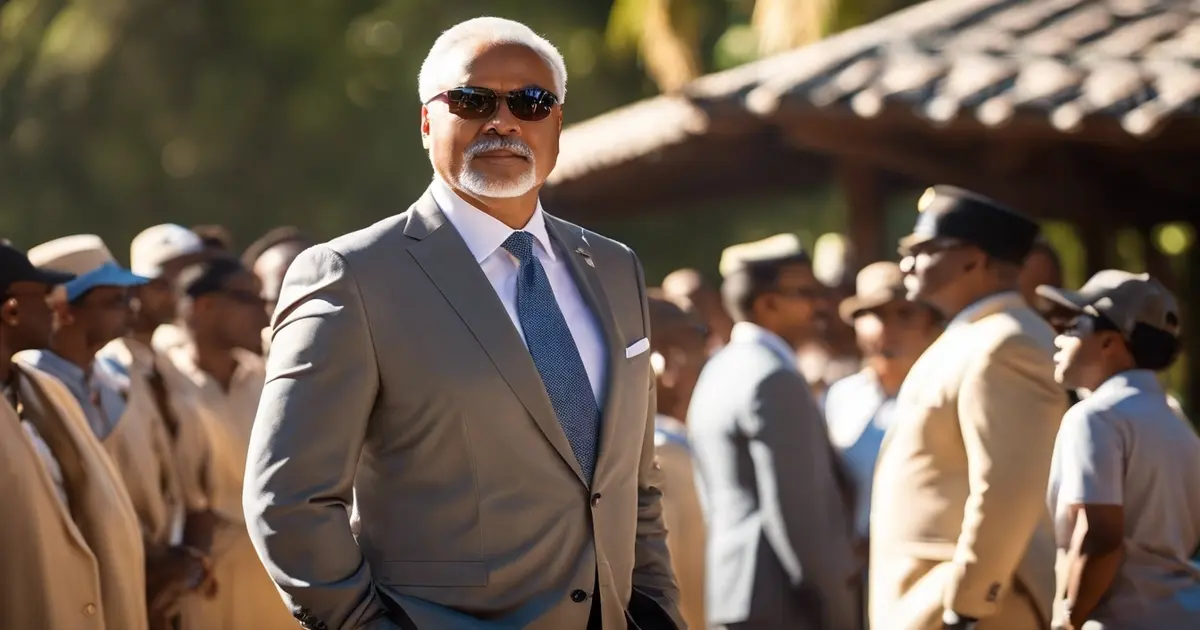Walk the Talk: Definition & Real-Life Examples
Discover the true meaning of walk the talk on our site. Expert insights & real-life examples to guide your understanding.

Walk the talk is behaving consistently with one's expressed beliefs, commitments or objectives. They apply it to evaluate trust, leadership, and brand integrity in the workplace, community projects, and everyday life. It says show me, not tell me. In teams, it manifests in transparent objectives, equitable input, and collective acknowledgment. In social impact work, it looks like transparent budgets, published results, and field voices. I initially witnessed its potency on a street clean-up in Marrakech, where weekly schedules morphed into brooms, bins, and neater nooks in less than a month. The concept transmits efficiently across cultures and occupations because action generates confidence quickly. The following sections unpack easy steps, examples, and tools to make it tangible.
" Leaders who walk the talk inspire stronger teams and healthier cultures. "
Key Takeaways
- Walk the talk is about credibility and trust in your personal life, professional life, and organization. Consider it your walk-the-talk daily manifesto.
- They trust those who walk the walk, and inconsistency quickly washes away trust and brand. Use clear commitments, transparent updates, and feedback loops to help keep the trust.
- Cognitive dissonance increases when behavior and principles conflict, damaging self-worth and connections. Take it down by making reasonable commitments, measuring results, and course correcting when discrepancies emerge.
- Leaders who walk the talk inspire stronger teams and healthier cultures. Share concrete examples, recognize shortcomings, and demonstrate your strategy to narrow the gap.
- Global commitments in health, environment, and business only count when supported by tangible action. Put transparent reporting, independent verification, and visible results first.
- Get started today with a monthly self-audit, public goals, and a simple tracker. Ask for candid input, record pledges, and revisit outcomes to keep you on track with your principles.

What Does "Walk the Talk" Mean?
It signifies the chasm between talk and walk—a crucial point for trust in mental health recovery, at home, at work, and in cross-cultural leadership.
1. The Core Definition
To 'walk the talk' is to practice what you preach. It means your decisions, habits, and compromises are consistent with the values you profess. They read this as evidence that you're genuine.
Integrity lies at the heart. Others feel stable enough to depend on you when behavior and commitments arise. When they don't, you risk being called a hypocrite, a dirty word that tears down credibility quickly around teams, families, and public life.
Some take the expression as a concise code for integrity‑based behavior. Others read it as matching the 'right' talk and 'right' walk for a role or culture. Others like it because it's shorter than "walk the walk and talk the talk."
2. Historical Roots
The idea traces to old wisdom: Aristotle's peripatetics linked learning with movement and practice, not talk alone. As English idioms go, it came from "talk the talk" (talk like an expert) and "walk the walk" (be an expert), which collided into the pithy "walk the talk." Recovery and mental health recovery services embraced it as a demand to implement, not just talk about, steps. This recovery philosophy is now found in numerous languages, adapted to local beliefs regarding honor and obligation. A twist is 'talk the walk.' Karl E. Weick calls it positive opportunism—walk the talk to get action started and new paths illuminated. Others "talk the walk" means sounding impressive while accomplishing little, near to "talk a good game," a warning against style, not substance.
3. Modern Usage
Today, it anchors accountability in business, government, and community groups. Leaders pledge equality in majority‑minority relations and support it with open salary ranges. A work–life balance manager boosts meeting hours to correspond. A business that vows low emissions posts third‑party takeaways. Management theory and political science indicate whether leaders lead by example, not slogans, and whether institutions follow through on public commitments.
HR and leadership training weave it into hiring, reviews, and ethics codes. Books, keynotes, and social media echo it because the test is apparent and straightforward.
4. Related Phrases
| Phrase | Nuance | Use case |
|---|---|---|
| Actions speak louder than words | Deeds carry more weight than claims | Public promises, audits |
| Practice what you preach | Hold yourself to your own rules | Teaching, parenting, mentoring |
| Lead by example | Model the standard you expect | Leadership, policy rollouts |
All strengthen the walk-the-talk philosophy. Use them interchangeably to fit tone and culture while ensuring that the deeds match the claims in a reasonable way.
Related Tips
The Psychology of Integrity
Integrity is the consistent practice of aligning actions with asserted values and beliefs. The concept of 'walk the talk' sits at the core of self-concept, as many people want their moral identity, words, and behavior to align. This alignment attracts others because it communicates trustworthiness, making you predictable and fair, which enhances relationships and leadership credibility. The psychology of integrity serves as a recovery philosophy that promotes universality and the wholeness of roles, from family to work to public office, where politicians must follow guidelines and be responsible.
Cognitive Dissonance
Cognitive dissonance is the psychological squeeze you experience when what you do and what you say don't align. You vow to be there on time, then come late and fabricate a reason. You swear to be honest, but you repeat a rumor. That gap arouses dissonance, guilt, or anxiety.
People ease the tension in two ways: changing their behavior to match their values or changing their values to justify their behavior. The former forges integrity, while the latter incubates further dissonance.
Every day instances are easy. To break a promise to a child. Exaggerating advancement in status. Agreeing yes at work when you know you'll miss the deadline. Habitual lying, into which most adults fall, magnifies tension and destroys tranquility.
Checklist to reduce dissonance:
- Define the top five values, write 'em down in simple language. Inspect weekly.
- Before a vow, examine power and hour; say no when required.
- Pssst... want to track your 'say–do' gaps in a journal! Note, triggers and fixes.
- Employ active coping under stress (plan, ask for help) instead of avoidant coping (delay, deny).
- Reframe stress as a challenge where you can challenge appraisals, connect with increased adaptive performance.
Trust Mechanisms
Trust expands when individuals synchronize their words and deeds throughout the years, with openness and follow-through as the cogs of a recovery philosophy. Psychological safety enables teams to confess mistakes without fear, which accelerates learning and adaptive performance, the knack for pivoting in the workplace. Pulakos et al. identify eight dimensions: managing stress, emergencies, and creative problem solving — cognitive abilities assist here, while high work stress can bog down results. In multiteam systems across units and even organizations, and high-performance teams that leave peers in the dust, tiny broken promises scale fast. Repeated inconsistency erodes trust quickly and is difficult to regain. Guardrails help: integrity tests during hiring to flag impulsive behavior; explicit norms on being impeccable with one's word; feedback loops that check follow-through; and shared dashboards that make commitments visible across teams and systems, aligning with the implementation toolkit for better outcomes.
Self-Perception
Striding your stride defines self. Individuals who agree in action and word experience themselves as trustworthy and genuine, which fortifies self-respect. They pick values instead of convenience, even when it's pricey, like turning down projects that conflict with principles or vision. Speaking with integrity—truthful, transparent, aware of impact—cultivates a calm mind and reduces the cost of secret schemes.
When actions spill, shame and self-woe lag. Use brief daily journaling to record promises made, promises kept, and one repair for any miss. Over time, alignment breeds quiet peace and well-being.

Consequences of Inconsistency
Not walking the talk hurts credibility, trust, and relationships, a key point in the recovery philosophy. These consequences radiate across teams, organizations, and communities, numbing impact and impeding transformation. In the long run, inconsistency tarnishes reputation; in the short term, it depletes energy.
Eroding Trust
Folks notice inconsistencies quickly. Inconsistency creates doubt, which then creates distance. Once trust is lost, coworkers, comrades, or constituents scan each other suspiciously, and even modest ambitions seem brittle.
Rebuilding is a slow and consistent process. Trust comes back only after unambiguous, replicable signals. You need stamina, not sloganeering.
- A manager who promises to reduce work but reassigns it unexpectedly.
- Brand claims eco goals, but waste per kg produced increases
- A parent bans screens, then scrolls during meals.
- A team lead promises weekly input, then disappears for months.
- A neighborhood organization demands respect, but silences fresh input from its choices.
Keep commitments to keep real. Capture them, give 'em owners, due dates, and progress logs in clear sight. Just a few updates pacify panic and demonstrate your sincerity. Traditions that value faith, hope, and charity—Christianity's so-called theological virtues—remind us that trust depends on embodied habit, not speech.
Damaging Reputation
Frequent stumbles accumulate to become a scarlet letter. Everybody hears what they see, not what they hear. Reviews, posts, and quiet referrals serve as a ledger of behavior, and one viral clip can balance out a slick statement. Reputation risk rises when status inconsistency muddles signals—Gerhard Lenski's mid-20th-century insight that mixed social positions determine outcomes remains controversial, with tenuous empirical connections between "objective" and "subjective" status (as Blocker and Riedesel observed). What matters here: mixed messages confuse audiences and invite scrutiny. To support mental health recovery, strategize by outlining inconsistencies by category (moral, business, public) and enumerating possible consequences (missed deal, collaborator defect, employee desertion, regulator interest). An implementation toolkit, like a straightforward table, assists executives in identifying trends and responding before blowback proliferates.
Stifling Progress
Work stalls when plans say one thing and actions say another. Teams make slow decisions, hedge risk, and cease sharing ideas. Emotional inconsistency—promises on Monday, panic on Friday—inflates stress, feeds anxiety, and transforms audacious goals into sure bets. Followership, an artful and deliberate craft, also pays a price; those in the rank and file retreat when chiefs evade follow‑through. Research says followers move results, but they require consistent signals. Narcissistic leadership complicates this more: early charm can lure a group, but over time, self‑interest and corporate narcissism drain momentum, while healthy self‑confidence paired with delivery can lift results. When signals conflict, motivation stalls, innovation hardens, and momentum becomes lost.
Establish defined, small, time‑bound objectives, associate each with a single owner, and post weekly status. Employ visible checkpoints, metric baselines, and short retros to stay on course. Plain drumming drowns elaboration.
Related Tips
"Walk the Talk" in Leadership
Great leaders set the example by walking the talk daily, embodying the recovery philosophy, emphasizing transparency, and accountability. Credibility is built on tangible, value-driven decisions that motivate, direct, and stabilize teams, making the mantra "walk the talk" a vital guideline for decision-making.
Inspiring Teams
People engage meaningfully when leaders deliver on promises and take responsibility for mistakes. Trust blooms as deeds align with beliefs—whether in a one-on-one review or an all-hands meeting. This consistent character drives commitment and authentic connection, reflecting the principles of a recovery philosophy.
Teams mimic what they observe. If a manager remains curious during reviews, learns new tools from the implementation toolkit, and gives explicit credit, others will likely replicate that behavior. The tone is set by example, not just slogans, emphasizing the importance of transparency and accountability.
Morale and productivity go hand in hand. Being a present, approachable, and servant-minded leader conveys that you care for people and results. Tell quick anecdotes at meetings about colleagues who did the tricky right thing—these spread quickly and shift standards.
Building Culture
Culture develops around what leaders walk, and what they don't walk. Employees look for signs about what is 'normal,' thus, a 'walk the talk' posture fosters accountability and integrity that policy alone cannot. Across disciplines—sociology, management, even religious history—charisma gets much of the credit for influence, but lasting cultures depend on consistency, not magnetic appeal. The word charisma, from the Ancient Greek χάρισμα, traverses biblical, historical, and sociological arguments, but its potency dissipates when actions fail to live up to pronouncements. Their Full Range Leadership Model mapped leader behavior from laissez-faire to transactional to transformational leadership, with steady engagement on the abscissa and effectiveness on the ordinate, and walking the talk pushing a leader up and to the right on that sketch. Practical steps help: write a short code of conduct in plain language, link it to core values, and review it in team forums. Implementing a recovery philosophy can anchor decisions in virtues you can identify—justice, bravery, moderation—resonating with Aristotle's Nicomachean Ethics and its attention to how to live well in a community. In many traditions — the Qur'anic concept of ulu'l-amr, for example — those entrusted with authority carry responsibility for equitable resolution of matters; authority deserves obedience when it is righteous, open, and embodied.
Driving Change
Change sticks when leaders walk the talk. If you request cross-team work, participate in it. If you want care with data, demonstrate your habits. Consistency soothes transition fear, reduces resistance, and maintains focus. Phony discontinuities–talk the talk, walk the walk–create cynicism, attrition, and decreased productivity.
Use a simple checklist: name the promise, name the first action, name who sees it, name how to measure it.

Beyond Words: Global Integrity
Global integrity means that our words are aligned with our actions, across borders and positions. It links personal integrity with public trust: confidence drops and self-respect erodes when leaders or any of us fail to walk the talk. This concept of 'walking the talk' emphasizes the importance of mental health recovery, as words provide signals—hedges, escape hatches, and fuzzy assertions are frequently a cover for feeble motivation. Truth is crucial in little things, and studies show almost 90% of people fall short of this mark, which is why the world's problems require honesty, evidence, and consistent effort.
Public Health
Public health is most effective when officials lead by example. Mask on, vaccine in, data in clear words, create a norm that propagates. Crowd psychology explains why: in groups, deindividuation and the sense that "everyone is doing it" shape behavior. Strong signals from leaders guide that collective consciousness.
Mixed signals hurt. If the guidance changes without cause or officials violate guidelines on film, confidence crumbles, and obedience ensues. Le Bon, Tarde, and Freud observed how crowds imitate apparent authority. In crises, panache loses to reliability.
- Exchange data sources and boundaries. Regular update.
- Always align words and acts in public settings.
- Use one message map across channels; cut jargon.
- Practice it on the spot, not just in memos.
- Conduct drills that simulate crowds in typical and emergencies.
- Maintain notes of advice, changes, and rationale for audit purposes.
Environmental Pledges
Climate and nature pledges matter solely when connected to quantified, time-bound, and objectively verified commitments. To ensure transparency, it's essential to publish a baseline and near-term targets, price carbon where legal, and show the math. Misses require solutions, not sleaze; thus, proper accounting and sound records management are crucial in transforming claims into accountable commitments.
| Pledge | Claimed Target | Outcome | Verification |
|---|---|---|---|
| Net-zero | 2050, scope 1–3 | Scope 3 ignored | Limited review |
| Plastic cut | 50% by 2025 | 15% reduction | Independent audit |
| Reforest | 1 million trees | 300k planted, low survival | Satellite check |
Corporate Responsibility
Real accountability arrives in pay equity, secure supply chains, fair taxation, and legitimate emissions reductions — not slick marketing. They're comparing receipts, ratings, and recalls across markets. Greenwashing jeopardizes brand equity and invites litigation. Build systems: yearly ESG targets tied to pay, supplier codes with spot checks, public dashboards, and external assurance. In governance parlance, accountability is answerability and, where appropriate, sanctions. Good records and complex accounting keep the accounting genuine. Leaders require professional development too—coaching, mentoring, and workshops with an evaluative phase—so that skills and ethics develop in tandem.
Words create culture. Beware of verbal tics, dodges, and dashes that avoid honesty. Do daily check-ins: what I said, what I did, what I will fix. Minor course corrections maintain integrity and personal power.
How to Practice Consistency
Consistency means your talk and your walk stay aligned — even when it's tough, embodying the philosophy of mental health recovery. It applies to people and teams in office halls and e-leadership, where work flows through videoconferences, shared documents, cellphones, and Wi‑Fi. Employ an implementation toolkit with easy-to-complete systems that make your intention conspicuous, quantifiable, and impossible to procrastinate.
Self-Audit
Conduct a brief self-audit every evening. Notice where your practice aligned with your principle and where it wandered. A rapid note in a notes app suffices.
Put commitments on paper and scan them weekly. Use precise phrases: "I will complete this task by Friday," not "I'll do it soon." Record easy habits, such as 'walk 3 km every day'.
Maintain a checklist or journal that connects goals to real actions. Cross-reference your calendar, chat logs, and project boards with what you committed to do. Identify one fix you will attempt tomorrow.
Block an hour a month for a deeper review. Score advancement, label trends, and re-establish a norm. Growth mindset aids here, treat gaps as data, not drama.
Set Public Goals
Render key goals to the public to increase the stakes and solicit assistance, aligning with the importance of transparency. Celebrate these goals — share them in team meetings, on social channels, or a community forum — especially when you lead through screens. State the promise in plain terms: "I will deliver the report by Friday 17:00," or "Our service will cut response time to under 12 hours by 30 June." Construct a dashboard visible to others—kanban columns, a basic progress bar, or a traffic-light status in your team tool, which is part of a practical implementation toolkit. Use peer check-ins on videoconference to maintain the drumbeat. Tie hiring and onboarding to this practice, with a realistic job preview that names both the good and the complex parts. That clarity establishes common standards pre-day one, makes objectives reasonable, and prevents executives from over-committing. Anticipate stress; it will arrive. Public goals + honest scope guard rails = keep you steady when deadline heat rises.
Seek Feedback
Request feedback from peers, mentors, and direct reports to identify discrepancies between words and deeds. Schedule brief, consistent check‑ins, and incorporate an anonymous quarterly survey to foster candid feedback. When tech change strains teams—new tools, clunky log‑ins, steep learning curves—feedback reveals where intent and impact diverge. Move quickly on what you learn, and say what you changed to show you walk the talk.
Structured learning assists as well. Leadership schools seek to mold leader behavior, but perceptions of "leadership" differ, and programs mirror founders' opinions. Regardless of certificates, diplomas, or degrees, it's about cultivating the habit of reflection and practice. Apply it to directing projects at a distance.

Conclusion
Align words and actions to walk the talk. People observe. Trust is built quickly with open actions. A manager makes a mistake in a team stand-up. A brand yanks a defective lot and reimburses quickly. A parent attends a school play after working a long day. Tiny actions add up. Teams feel safe. Clients return. Culture goes powerful.
To stay sane, maintain a brief promise list. Tell us ONE metric you're going to hit this week. Have a peer verify your follow-through. Provide fast notes on wins and slips. Repeat the cycle. Results talk.
Ready to walk the talk? Choose a promise, identify a singular action, and fix a deadline. Then, pass the plan on to your crew today.







